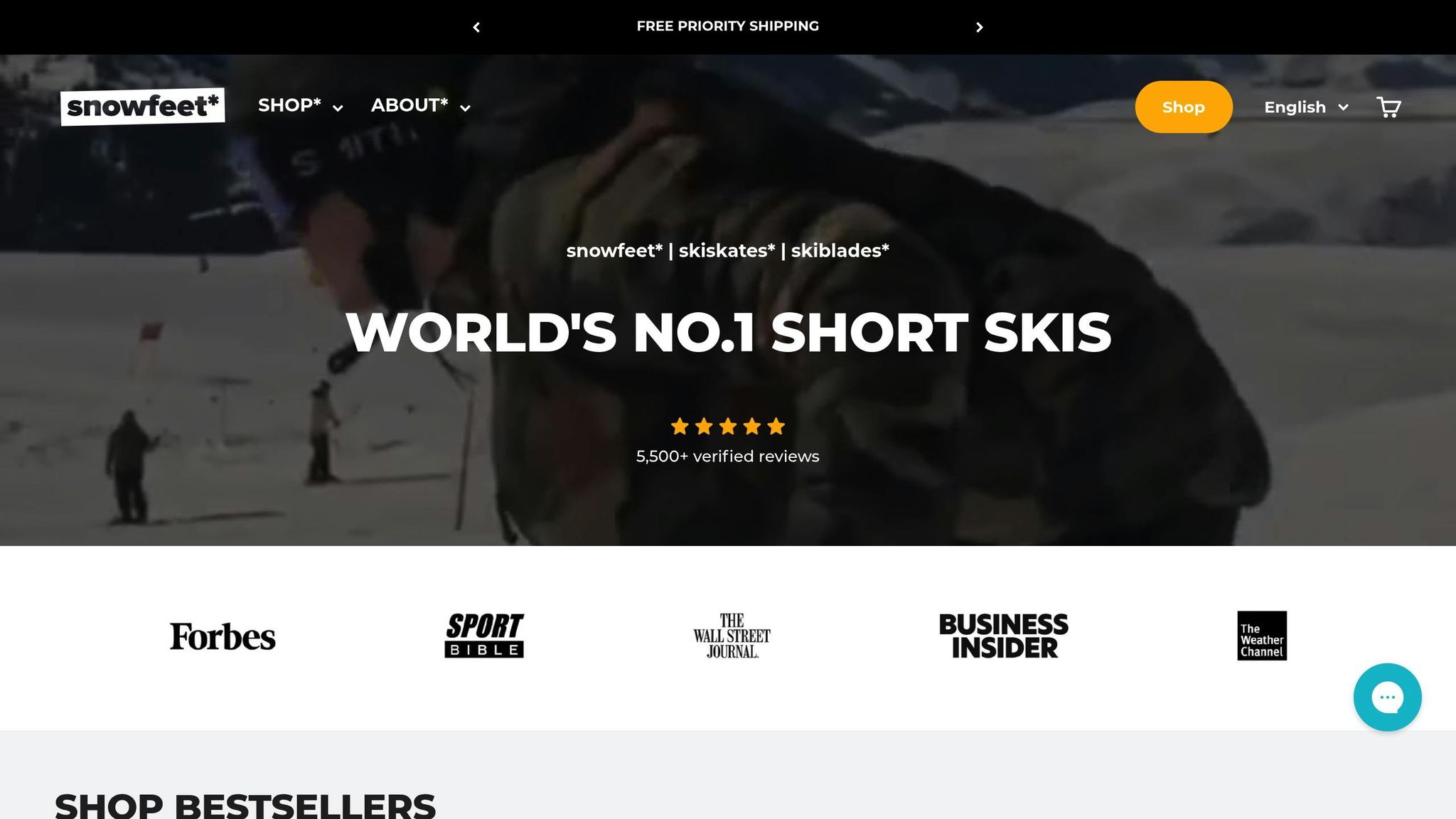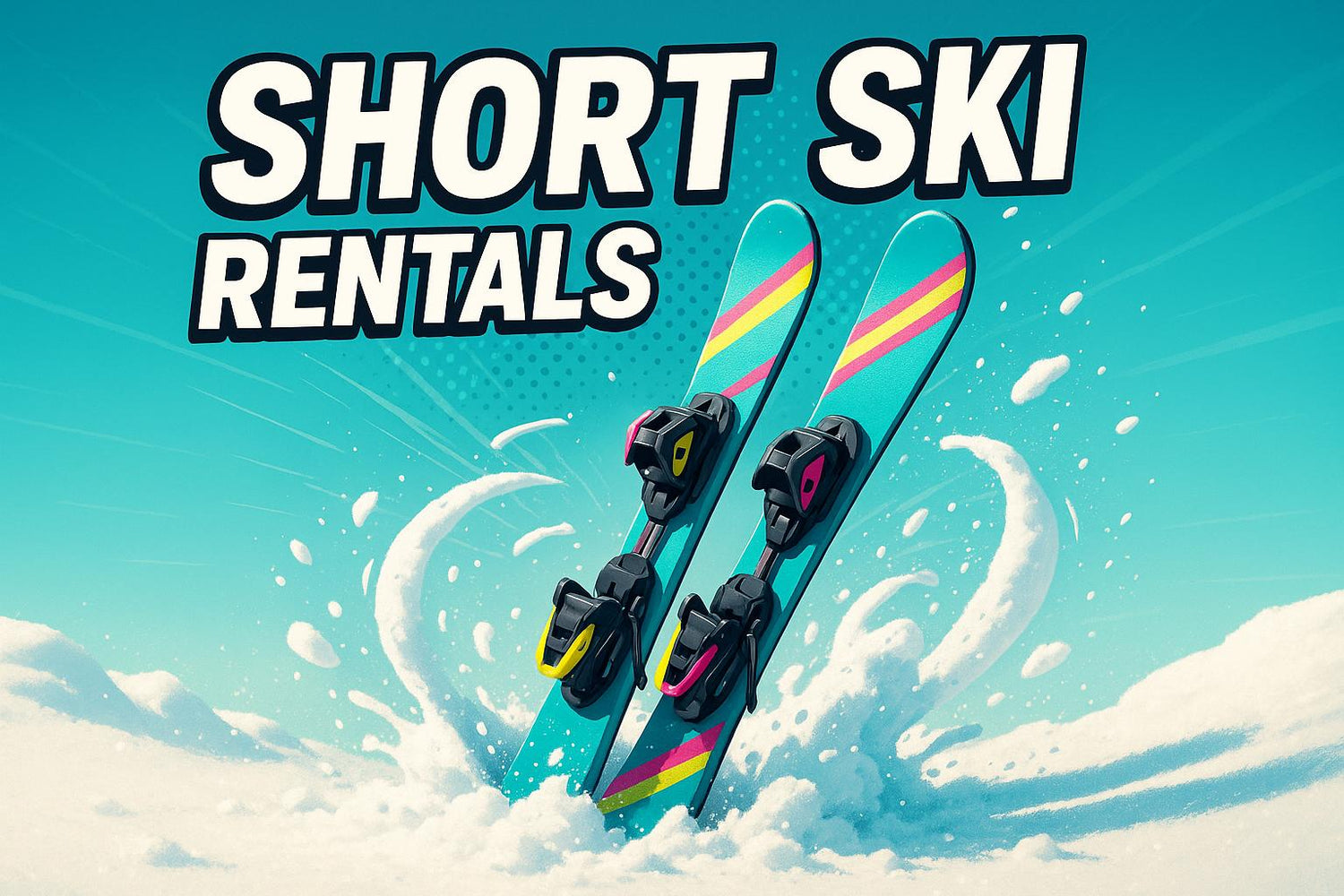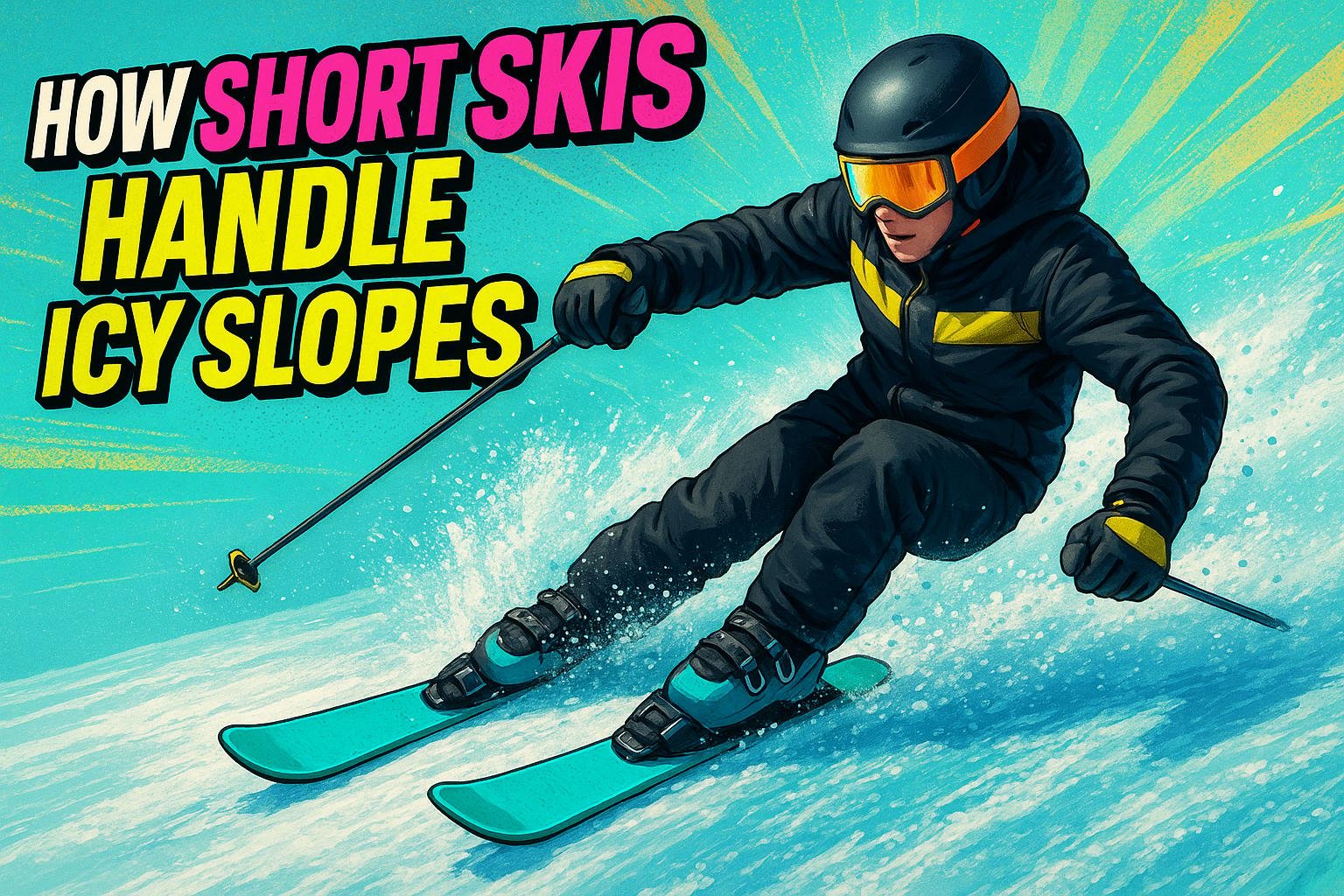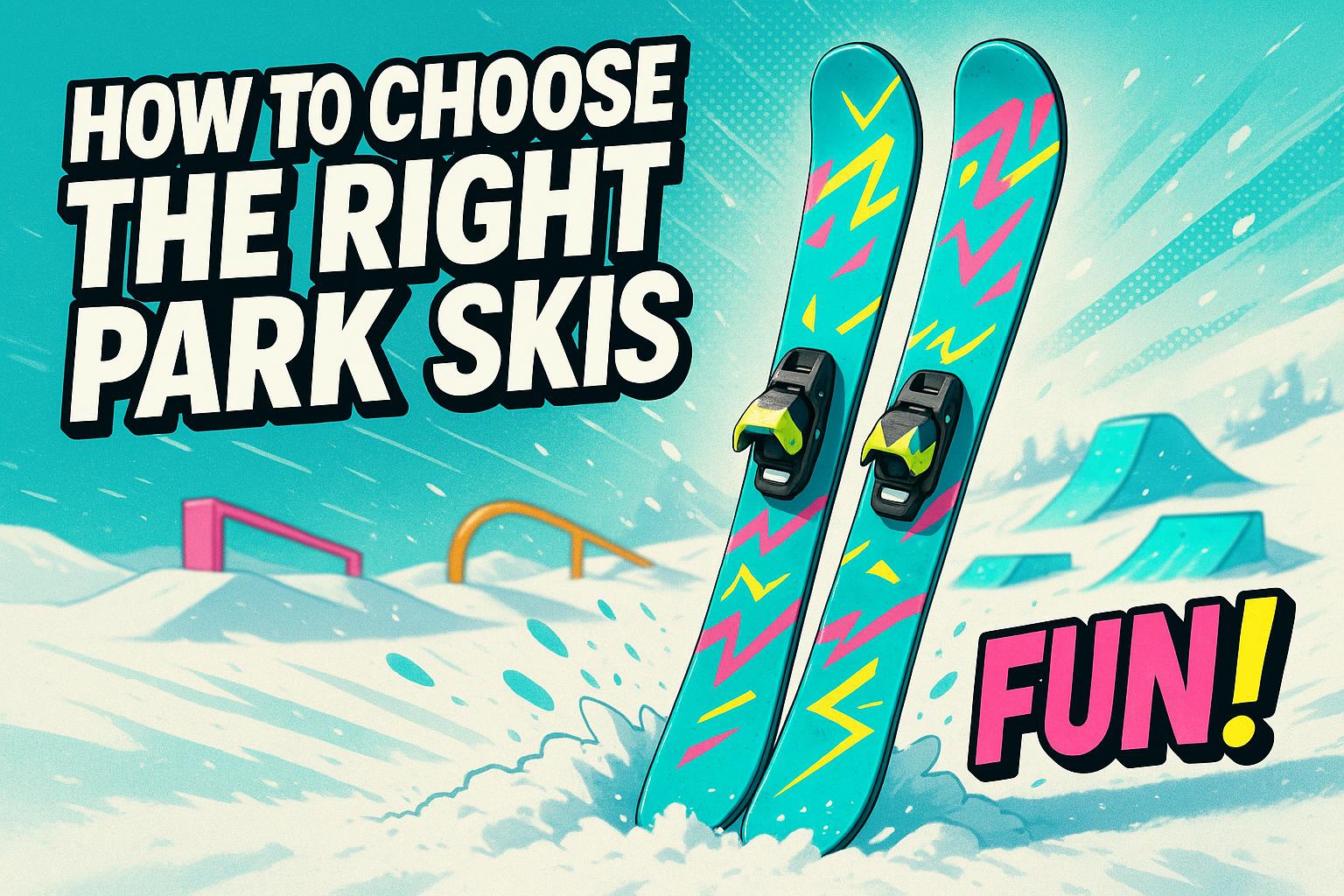Short Skis revolutionieren das Skifahren, indem sie leichter, einfacher zu kontrollieren und viel spaßiger sind. Hier ist, was du wissen musst:
- Was sind Short Skis? Skier unter 63 Zoll (160 cm) Länge, einige sogar so kurz wie 15 Zoll (38 cm), wie die Snowfeet's Mini Ski Skates. Sie sind ideal für Anfänger, Freestyle-Tricks und enge Kurven.
- Warum Kurzski wählen? Sie sind tragbar, anfängerfreundlich und funktionieren mit normalen Winterschuhen oder Skischuhen. Perfekt für Pisten, Terrainparks oder sogar deinen eigenen Garten.
- Wo mieten? Optionen sind Resort-Mieten (teurer), lokale Skigeschäfte (günstiger) und Online-Dienste (bequem). Snowfeet bietet sogar direkten Online-Kauf an.
- Kosten? Die Mietpreise in Resorts liegen zwischen 62 und 80 $/Tag, während lokale Geschäfte ab 39 $/Tag starten. Snowfeet-Produkte beginnen bei 150 $, was sie zu einer langfristigen Kosteneinsparung macht.
Kurzer Vergleich: Kurzski vs. Lange Ski
| Merkmal | Kurzski (Snowfeet) | Lange Ski (Traditionell) |
|---|---|---|
| Manövrierfähigkeit | Schnell, reaktionsfreudig | Erfordert mehr Anstrengung |
| Geschwindigkeitsstabilität | Mittlere Geschwindigkeiten | Besser bei hohen Geschwindigkeiten |
| Lernkurve | Einfacher für Anfänger | Langsamer zu erlernen |
| Portabilität | Passt in Rucksäcke | Unhandlich, benötigt Halterungen |
Kurzski, angeführt von Marken wie Snowfeet, machen das Skifahren für alle zugänglicher, tragbarer und spaßiger. Ob Miete oder Kauf – sie sind eine großartige Wahl für dein nächstes Winterabenteuer.
Arten von Kurzski und Mietoptionen
Kurzski-Typen erklärt
Kurzski gibt es in verschiedenen Ausführungen, die jeweils für unterschiedliche Erlebnisse auf der Piste entwickelt wurden. Die richtige Wahl kann dein Winterabenteuer noch angenehmer machen.
Mini Ski Skates sind die kleinste Option auf dem Markt. Nehmen wir zum Beispiel die Snowfeet* Mini Ski Skates – sie sind nur 38 cm (15 Zoll) lang und können mit deinen normalen Winterstiefeln verwendet werden. Super kompakt und einfach zu handhaben!
Skiskates verbinden Skifahren und Schlittschuhlaufen zu einer Einheit. Die Skiskates von Snowfeet*, etwa 44 cm (17 Zoll) lang, bieten eine lebhafte und verspielte Fahrt, die sich völlig anders anfühlt als traditionelle Kurzski von Marken wie Rossignol oder Atomic.
Skiblades und Skiboards sind etwas länger und reichen typischerweise von 65 cm (26 Zoll) bis 120 cm (47 Zoll). Bekannte Marken wie Rossignol, Atomic und Head stellen diese in einem Stil her, der traditionellen Skiern ähnelt, aber in einem kleineren Format. Snowfeet* bietet ebenfalls Skiblades und Skiboards in dieser Größenordnung an, jedoch mit einem Twist – sie können mit normalen Winterschuhen, Snowboardstiefeln oder Skischuhen verwendet werden. Im Gegensatz zu traditionellen Kurzski, die spezielle Skischuhe erfordern und hauptsächlich für Standard-Skitechniken gedacht sind, sind Snowfeet*-Produkte vielseitig einsetzbar. Du kannst sie auf Skipisten, Wanderwegen, Rodelhügeln oder sogar in deinem eigenen Garten nutzen.
"Snowfeet und Skiskates sind Skates für den Schnee, ein völlig neuer Wintersport namens Skiskating, der dem Schlittschuhlaufen auf Schnee ähnelt. Sie ermöglichen neue Arten von Sprüngen, Drehungen und Tricks... Wenn du etwas völlig Neues ausprobieren und vor allem Spaß haben möchtest, sind diese die beste Wahl für dich."
Jetzt, wo du die Arten von Short Skis kennst, sprechen wir darüber, wie du sie bekommst.
Verfügbare Mietoptionen
Short Skis zu mieten ist eine praktische Möglichkeit, sie auszuprobieren, ohne sich zum Kauf zu verpflichten, aber die Verfügbarkeit hängt davon ab, wo du suchst.
Resort-Verleihe führen meist Skiblades und Skiboards von großen Marken wie Head, Atomic und Rossignol. Diese sind ideal, wenn du traditionelle Skistile bevorzugst und keine Probleme mit Skischuhen hast.
Lokale Skigeschäfte sind eine fantastische Alternative, wenn du etwas Besonderes suchst. Sie haben oft eine größere Auswahl und flexiblere Mietbedingungen, besonders für mehrtägige Trips. Außerdem erhältst du persönlichen Service, was den Unterschied machen kann, wenn du die richtige Ausrüstung suchst.
Online-Verleihdienste sind zur bequemen Anlaufstelle geworden. Sie ermöglichen es dir, Preise zu vergleichen, im Voraus zu buchen und innovative Optionen wie mini ski skates oder Skiskates einfach zu sichern. Snowfeet* bietet sogar eine direkte Online-Bestellung an, was es einfach macht, ihre einzigartigen Produkte auszuprobieren, ohne sie in einem Verleihshop suchen zu müssen.
"Im Allgemeinen bieten Short Skis mehr Spaß und Bewegungsfreiheit, sie sind verspielt, reaktionsfreudig, leicht an den Füßen, einfacher zu stoppen und für viele Skifahrer leichter zu fahren als sperrige lange Skis."
6 TIPPS Wie du den richtigen Mietski für deinen Skiurlaub auswählst
Wie man die richtigen Short Skis für die Miete auswählt
Die Wahl der richtigen Short Skis für die Miete hängt von einer Mischung aus deinem Können, deinem Körpertyp und dem Gelände ab, das du befahren möchtest. Short Skis sind bekannt für ihre Flexibilität und Nachgiebigkeit, was sie zu einer großartigen Option für viele Skifahrer macht.
Größenüberlegungen
Dein Können steht an erster Stelle bei der Entscheidung über die Länge der Short Skis. Wenn du Anfänger bist oder noch Vertrauen aufbauen möchtest, solltest du Skis unter 39 Zoll (100 cm) wählen. Diese kürzeren Längen erleichtern das Lernen, bieten sanftere Kurven und sind weniger einschüchternd im Vergleich zu traditionellen Skis, die normalerweise 59–79 Zoll (150–200 cm) lang sind.
Für erfahrenere Skifahrer, die regelmäßig die Pisten besuchen, sind Skis im Bereich von 46–54 Zoll (116–136 cm) eine solide Wahl. Diese Größen bieten eine gute Balance zwischen Kontrolle und Leistung und sind dabei leichter und handlicher als Voll-Länge-Skis.
Das Gelände, auf dem du fahren möchtest, ist ebenfalls wichtig. Kürzere Skis sind perfekt, um enge Baumgruppen, technische Trails und schnelle, verspielte Kurven zu meistern. Andererseits kann ein etwas längerer Ski besser geeignet sein, wenn du auf hohe Geschwindigkeiten oder tieferen Schnee abzielst.
| Fähigkeitsniveau | Traditionelle Short Skis | Snowfeet* Vorteil |
|---|---|---|
| Anfänger | 39 Zoll (100 cm) oder weniger | Mini Ski Skates (15 Zoll/38 cm) – sehr nachgiebig |
| Mittelstufe | 46–54 Zoll (116–136 cm) | Skiblades (26–39 Zoll/65–99 cm) – großartige Balance |
| Fortgeschritten | 47+ Zoll (120+ cm) | Short Skis (47 Zoll/120 cm) – maximale Vielseitigkeit |
Das leichte Design und die verstellbaren Bindungen von Snowfeet* bieten zusätzliche Flexibilität und passen sich mühelos Ihren Bewegungen an.
Fragen, die Sie vor der Miete stellen sollten
Bevor Sie mieten, stellen Sie sicher, dass Sie ein paar wichtige Fragen stellen, um sicherzugehen, dass die Ski Ihren Anforderungen entsprechen:
- Schuhkompatibilität: Traditionelle Verleihsysteme erfordern oft separate Skischuhe, was Kosten und Aufwand erhöht. Fragen Sie den Shop: „Welche Schuhgrößen bieten Sie an?“ und „Sind die Bindungen verstellbar?“ Snowfeet*-Produkte hingegen funktionieren mit Ihren üblichen Winterstiefeln, Snowboardstiefeln oder Skischuhen, was vieles vereinfacht.
- Befestigungsqualität und Einstellung: Um sicher zu bleiben und die beste Leistung zu erzielen, fragen Sie: „Wann wurden diese Bindungen zuletzt überprüft?“ und „Können die Auslösewerte an mein Können angepasst werden?“ Snowfeet*-Produkte kommen mit zuverlässigen, leicht verstellbaren Bindungen.
- Geländetauglichkeit: Überprüfen Sie genau, ob die Ski für das Gelände geeignet sind, das Sie erkunden möchten. Fragen Sie zum Beispiel, ob sie für Terrainparks geeignet sind oder wie sie im Pulverschnee funktionieren. Während viele traditionelle Short Skis am besten auf präparierten Pisten sind, ist Snowfeet*-Ausrüstung für Vielfalt gebaut – sie bewältigt präparierte Abfahrten, Terrainparks und sogar Off-Trail-Abenteuer.
- Mietbedingungen und Schadensrichtlinien: Erhalten Sie Details zu Kosten, wie Tages- versus Mehrtagespreise, und klären Sie deren Schadensrichtlinie. Einige Shops verlangen hohe Gebühren für kleine Kratzer oder Kantenschäden. Snowfeet*-Produkte hingegen sind langlebig konzipiert und werden vom Unternehmen stark unterstützt.
Snowfeet* hebt das Mieterlebnis auf ein ganz neues Level und verbindet Benutzerfreundlichkeit mit Vielseitigkeit. Während Marken wie Rossignol und Head sich auf traditionelle Short-Ski-Designs konzentrieren, hat Snowfeet* das Konzept neu gedacht und macht das Skifahren für alle zugänglicher und spaßiger.
Wo man in den Vereinigten Staaten Short Skis mieten kann
Den richtigen Ort für die Skimiete zu wählen, kann Ihre Zeit auf der Piste entscheidend beeinflussen. Sie haben drei Hauptoptionen: Verleihshops in Skigebieten, lokale Skigeschäfte und Online-Plattformen. Jede Option hat ihre Vor- und Nachteile, also lassen Sie uns das aufschlüsseln, um Ihnen bei der Entscheidung zu helfen, was am besten zu Ihrem Budget, Ihrer Bequemlichkeit und Ihren Bedürfnissen passt.
Resort vs. Lokale Geschäfte vs. Online-Verleih
Resort-Verleih dreht sich alles um Bequemlichkeit. Du kannst deine Ausrüstung direkt an der Bergbasis abholen, und wenn sich etwas nicht richtig anfühlt, ist der Austausch der Ausrüstung normalerweise schnell und einfach. Der Nachteil? Du zahlst für diese Bequemlichkeit. Rechne mit etwa $62 pro Tag für Basisausrüstung oder bis zu $80 täglich für Performance-Pakete. Außerdem solltest du dich auf lange Warteschlangen einstellen – besonders an Wochenenden und Feiertagen.
Lokale Skigeschäfte sind eine großartige Möglichkeit, etwas Geld zu sparen. Sie bieten niedrigere Preise im Vergleich zu Resorts, mit Anfängerpaketen ab $39, Mittelstufen-Sets um $45 und Performance- oder Demo-Paketen von $50–$60. Der Haken? Du musst eine zusätzliche Fahrt machen, um deine Ausrüstung abzuholen und zurückzugeben, was deine Zeit beanspruchen kann.
Online-Verleih hat eine ganz neue Bequemlichkeit gebracht. Du kannst von zu Hause aus einkaufen und aus einer riesigen Auswahl an Skiern wählen. Ben Rabinowitz, Verkaufsberater bei 2Backcountry.com, bringt es perfekt auf den Punkt:
"Während der Preis wichtig ist und es online einfacher ist, den besten Preis zu finden, ist der Preis nicht der einzige Grund, online zu kaufen... Beim Online-Shopping ist die Auswahl fast grenzenlos – du kannst jede Art von Ski in jeder Größe, Länge, Form oder Design finden, das du möchtest."
Das heißt, online zu bestellen kann knifflig sein, wenn es darum geht, die perfekte Passform zu finden. Rückgaben oder Umtausch können auch lästig sein, besonders wenn du einen engen Zeitplan hast.
Hier ist ein schneller Vergleich, der dir hilft, deine Optionen abzuwägen:
| Mietoption | Bequemlichkeit | Tageskosten | Auswahl | Passform-Garantie |
|---|---|---|---|---|
| Resort-Geschäfte | Hoch (vor Ort) | $62–$80 | Begrenzt | Einfache Umtauschmöglichkeiten |
| Lokale Geschäfte | Mittel (Reise erforderlich) | $39–$60 | Breiter als Skigebiete | Rückfahrt erforderlich |
| Online-Verleih | Hoch (Shoppen von zu Hause) | Variiert | Sehr breit | Anspruchsvoll |
| Snowfeet*-Kauf | Höchste (für immer besitzen) | 0 $ nach dem Kauf | Vollständige Produktlinie | Detaillierte Größentabellen |
Warum Snowfeet* Ihre beste Wahl sein könnte

Wenn Sie es leid sind, Ausrüstung zu mieten, bietet Snowfeet* einen ganz anderen Ansatz. Statt bei jeder Fahrt Mietgebühren zu zahlen, können Sie Ihre Ausrüstung komplett besitzen. Die Preise beginnen bei 150 $ für die 38 CM Mini Ski Skates und reichen bis zu 690 $ für die 120 CM Short Skis. Je nachdem, wie oft Sie Ski fahren, kann das auf lange Sicht Geld sparen – besonders da Snowfeet*-Ausrüstung mit Ihren vorhandenen Winterstiefeln, Snowboardstiefeln oder Skischuhen funktioniert. Kein zusätzlicher Schuhverleih nötig!
Eigene Snowfeet*-Ausrüstung zu besitzen bedeutet keine Warteschlangen oder Gebühren mehr beim Verleih, und Sie haben immer einsatzbereite Ausrüstung.
Tipps zum Finden der besten Angebote
Möchten Sie noch mehr sparen? Hier sind ein paar Tipps, die Sie beachten sollten:
- Online buchen: Viele Verleihshops bieten 10–20 % Rabatt, wenn Sie im Voraus reservieren.
- Reisen Sie außerhalb der Hauptsaison: Skifahren zu ruhigeren Zeiten oder in weniger beliebten Skigebieten kann zu besseren Preisen führen. Zum Beispiel bietet Christy Sports Saisonmietpakete ab 159 $ an.
- Bündeln Sie Ihre Services: Suchen Sie nach Angeboten, die Liftkarten, Verleih und Unterkunft kombinieren. Wenn Sie einen Epic Pass haben, können Sie mit Epic Mountain Rewards zusätzlich 20 % bei Verleih sparen – und eine Online-Buchung im Voraus kann weitere 20 % Rabatt bringen.
- Auf Gutscheine achten: Einige lokale Shops geben Rabatte auf Skibrillen, Helme oder Stöcke, wenn du Ausrüstung mietest.
Für das ultimative Angebot solltest du den Verleih ganz überspringen und in Snowfeet* investieren. Die 38 CM Mini Ski Skates bei $150 kostet weniger als drei Tage Premium-Verleih im Resort, und das 50 CM PRO Modell bei $199 kann sich schon nach wenigen Fahrten amortisieren.
Ein letzter Tipp: Überprüfe die Regeln in deinem Skigebiet. Während die meisten Berge Snowfeet*-Produkte willkommen heißen, ist es immer klug, dies im Voraus zu bestätigen, um Überraschungen an der Kasse zu vermeiden.
Die Verleihlandschaft verändert sich, da immer mehr Skifahrer kürzere, wendigere Skier annehmen. Snowfeet* hat sich einen Namen gemacht, indem sie Ausrüstung anbieten, die nicht nur praktisch, sondern auch auf ein persönlicheres und spaßigeres Wintersporterlebnis zugeschnitten ist.
sbb-itb-17ade95
Kurze Skier vs. Lange Skier: Warum kurz gehen?
Lass uns eintauchen, warum kurze Skier das Spiel für Skifahrer überall verändern. Jahrelang setzte die Skiwelt auf längere Skier – über 67 Zoll (170 cm) – von Marken wie Rossignol, Atomic und Head. Aber jetzt schaffen kurze Skier, typischerweise unter 63 Zoll (160 cm), ihren eigenen Platz. Snowfeet* bietet zum Beispiel Modelle von ultra-kurz 17 Zoll (44 cm) bis 55 Zoll (140 cm) an, und sie bringen einige ernsthafte Vorteile auf die Piste.
Kurze Skier sind leichter, flexibler und perfekt für schnelle Kurven, scharfe Stopps und verspielte Moves wie Spins und Sprünge. Wenn du auf Tricks stehst oder einfach das Gefühl haben willst, auf Schnee zu skaten, sind extreme kurze Skier – wie die von Snowfeet* – ein echter Game-Changer. Ihre Skiskates-Produkte bringen eine ganz neue Stimmung in den Wintersport.
Vergleichstabelle: Kurze Skier vs. Lange Skier
Hier ein kurzer Überblick, wie sich kurze Skier gegenüber traditionellen langen Skiern schlagen:
| Merkmal | Kurze Skier (Snowfeet*) | Lange Skier (Rossignol, Atomic, Head) |
|---|---|---|
| Manövrierfähigkeit | Schnelle, reaktionsfreudige Kurven | Erfordert mehr Aufwand in engen Bereichen |
| Geschwindigkeitsstabilität | Ideal für moderate Geschwindigkeiten | Stabiler bei hohen Geschwindigkeiten |
| Verspieltheit | Perfekt für Tricks und Sprünge | Bietet ein bodenständigeres Erlebnis |
| Lernkurve | Einfacher für Anfänger | Langsamer, erfordert mehr Können |
| Portabilität | Passt leicht in Rucksäcke | Benötigt Dachträger oder Skitaschen |
| Fähigkeitsniveau | Anfänger bis Fortgeschritten | Fortgeschritten bis Experte |
| Gewicht | Leicht und einfach zu handhaben | Schwerer, erfordert mehr Kraftaufwand |
Ein herausragender Vorteil der kurzen Snowfeet* Skier ist ihre Portabilität. Ihre 15-Zoll (38 cm) Mini Ski Skates passen problemlos in einen Rucksack, was ein großer Unterschied zu den Dachträgern oder sperrigen Skitaschen ist, die für traditionelle Modelle von Marken wie Atomic oder Head benötigt werden.
Kurze Skier machen das Lernen auch zum Kinderspiel. Ihr leichtes Design und die einfache Manövrierbarkeit helfen Anfängern, ihr Gleichgewicht zu finden und scharfe Kurven mit weniger Mühe zu meistern. Snowfeet* bietet Größen von 26 Zoll (65 cm) bis 47 Zoll (120 cm) an, was sie ideal für neue Skifahrer macht. Und für alle, die etwas völlig anderes ausprobieren wollen, bieten ihre ultra-kurzen Skiskates – unter 20 Zoll (50 cm) – eine frische, spaßige Art, den Schnee zu erobern.
Die Vision von Snowfeet*: Wintersport verändern
Snowfeet* macht nicht einfach nur kurze Skier – sie denken Wintersport neu. Gegründet von Zbynek und Michael, hat dieses zukunftsorientierte Unternehmen einen großen Traum: Skiskates eines Tages zu einer olympischen Disziplin zu machen.
Ihr Ansatz stellt die langjährige Überzeugung infrage, dass größere Ski besser für Geschwindigkeit und Stabilität sind. Snowfeet* kehrt diese Idee um und beweist, dass kürzere Ski das Skifahren für alle spaßiger, zugänglicher und leichter machen können. Während traditionelle Marken wie Rossignol, Atomic und Head sich auf längere, leistungsstarke Ski konzentrieren, die Jahre brauchen, um sie zu meistern, geht es Snowfeet* darum, die Pisten für Skifahrer aller Niveaus genussvoll zu machen. Eine mutige Vision, die schnell Anklang findet.
Fazit: Warum kurze Ski die Zukunft des Wintersports sind
Kurze Ski verändern das Spiel, machen das Skifahren zugänglicher, portabler und, seien wir ehrlich, viel spaßiger. Traditionelle lange Ski haben zwar ihren Platz, aber kurze Ski brechen Barrieren ab und öffnen den Sport für mehr Menschen.
Darum: kürzere, weichere und schmalere Ski sind leichter zu handhaben und zu kontrollieren, besonders für Anfänger. Sie vereinfachen den Lernprozess und machen das Skifahren weniger einschüchternd. Außerdem gibt es einen praktischen Bonus – du kannst oft deine normalen Winterstiefel verwenden, anstatt teures Spezial-Equipment zu kaufen. Das ist ein Gewinn für Bequemlichkeit und deinen Geldbeutel.
An der Spitze dieses Wandels steht Snowfeet*. Sie verändern nicht nur alte Designs; sie denken den Wintersport komplett neu. Ihre Mini Ski Skates sind zum Beispiel nur 15 Zoll (38 cm) lang und damit ultra-portabel. Für diejenigen, die etwas mehr Länge bevorzugen, reicht ihr Sortiment bis zu 47 Zoll (120 cm). Diese Auswahl bedeutet, dass für jeden etwas dabei ist, egal ob du kompletter Anfänger oder erfahrener Skifahrer bist, der Abwechslung sucht.
Was Snowfeet* besonders macht, ist ihre Vision, Wintersport spontaner und zugänglicher zu gestalten. Vergiss teure Liftkarten und überfüllte Skigebiete – ihre Produkte funktionieren genauso gut in deinem lokalen Park, im Garten oder an jedem verschneiten Hügel, den du findest. Sie sind auch unglaublich portabel. Du kannst sie ins Gepäck werfen, in öffentlichen Verkehrsmitteln mitnehmen oder in einer kleinen Wohnung verstauen. Kein sperriges Equipment nötig.
Und sie hören hier nicht auf. Snowfeet* erweitert die Grenzen mit Skiskates und strebt an, diese Sportart eines Tages bei den Olympischen Spielen zu sehen. Dieser mutige Schritt stellt die altmodische Vorstellung infrage, dass größere Ski immer besser sind. Stattdessen beweisen sie, dass kleinere Ski ein aufregenderes und angenehmeres Erlebnis bieten können und ebnen den Weg für eine neue Ära im Wintersport.
Snowfeet* bietet eine Vielzahl von Produkten, die unterschiedlichen Bedürfnissen und Könnerstufen gerecht werden. Ihre Shop-Seite ist vollgepackt mit detaillierten Infos zu Preisen und Funktionen, sodass du ganz einfach die perfekte Wahl findest. Egal, ob du gerade erst anfängst oder eine neue Art suchst, die Pisten zu genießen, Snowfeet* hat etwas entwickelt, das Wintersport spaßiger, freier und zugänglicher macht.
Die Zukunft des Skifahrens ist kürzer, leichter und leichter zu lieben – und Snowfeet* führt die Bewegung an.
FAQs
Sind Short Skis wie Snowfeet für Anfänger leichter zu erlernen als traditionelle Skier?
Short Skis, wie die von Snowfeet, sind oft eine tolle Wahl für Anfänger. Ihre kompakte Größe macht sie leichter zu handhaben und gibt neuen Skifahrern von Anfang an ein Gefühl von Kontrolle und Stabilität. Viele Menschen lernen den Umgang mit Snowfeet-Produkten schnell, da die Lernkurve im Vergleich zu traditionellen Skiern deutlich kürzer ist.
Im Gegensatz zu längeren Skiern von Marken wie Rossignol oder Atomic, die oft sperrig und schwer zu manövrieren sind, bietet das kürzere Design von Snowfeet bessere Wendigkeit und schnellere Reaktionsfähigkeit. Das macht sie ideal für alle, die auf spaßige und entspannte Weise ins Skifahren einsteigen wollen. Außerdem ist ihr leichtes und tragbares Design besonders praktisch für Anfänger.
Warum Snowfeet-Produkte wählen statt traditionelle Skier im Resort zu mieten?
Snowfeet-Produkte bringen frischen Wind in die Welt des Skifahrens. Anders als die sperrigen Skier, die man normalerweise von Marken wie Rossignol oder Atomic mietet, macht das kurze und leichte Design von Snowfeet sie super handlich. Sie sind perfekt für schnelle Kurven und das Slalomfahren auf vollen Pisten. Und weil sie so kompakt sind, können Sie sie mühelos tragen – kein schweres Gepäck mehr schleppen.
Was Snowfeet wirklich auszeichnet, ist ihre Flexibilität. Sie können sie mit normalen Winterschuhen, Snowboardboots oder Skischuhen verwenden, was sie zu einer großartigen Option für Anfänger und Gelegenheitsfahrer macht. Ihr cleveres Design stellt die Vorstellung infrage, dass längere Skier immer besser sind. Stattdessen bieten sie ein verspieltes, agiles Erlebnis, das ganz auf Spaß und Freiheit im Schnee setzt. Wenn Sie bereit sind, Neues auszuprobieren, zeigt Snowfeet, dass Skifahren nicht immer der Tradition folgen muss.
Sind Snowfeet-Produkte für unterschiedliche Gelände und Skistile geeignet?
Sind Snowfeet-Produkte vielseitig einsetzbar?
Snowfeet-Ausrüstung ist darauf ausgelegt, verschiedene Gelände und Skistile zu meistern. Ob Sie nun auf präparierten Pisten cruisen, Tricks im Park ausprobieren oder durch leichten Pulverschnee gleiten – ihr kompaktes, leichtes Design macht sie super einfach zu kontrollieren. Außerdem gibt es verschiedene Modelle, sodass für fast jeden Geschmack etwas dabei ist.
Wenn Sie Snowfeet mit traditionellen Skiern von Marken wie Rossignol oder Atomic vergleichen, gibt es einen entscheidenden Unterschied im Fokus. Diese klassischen langen Skier stehen für Geschwindigkeit und Stabilität. Snowfeet hingegen setzen ganz auf Spaß und ein Gefühl von Freiheit auf der Piste. Auch wenn sie nicht Ihre erste Wahl für tiefe Pulvertage sind, glänzen sie im Freestyle, bei Backcountry-Abenteuern und als spielerische Alternative zur Standard-Skiausrüstung.


































Hinterlassen Sie einen Kommentar
Diese Website ist durch hCaptcha geschützt und es gelten die allgemeinen Geschäftsbedingungen und Datenschutzbestimmungen von hCaptcha.